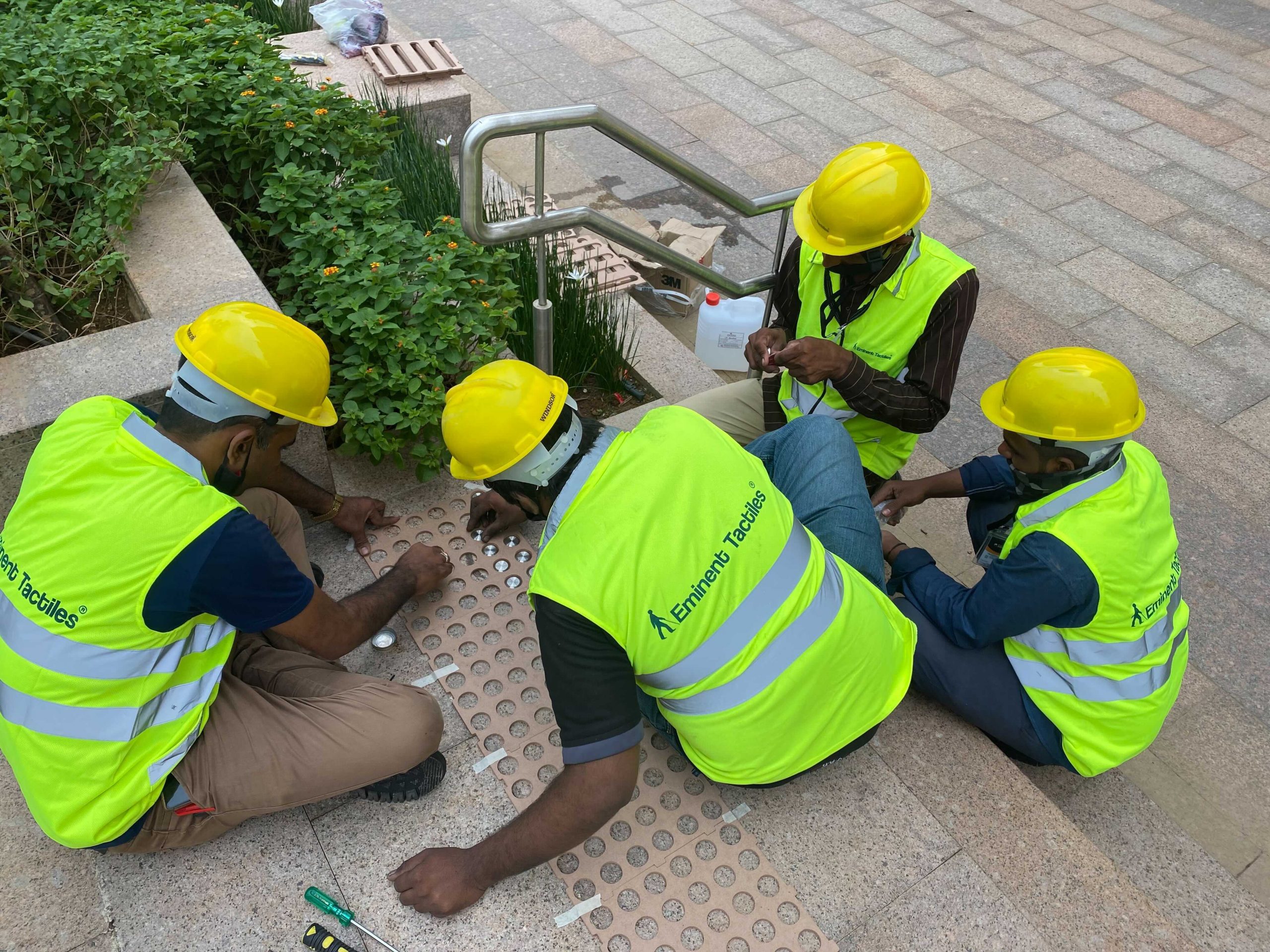
Tactile Ground Surface Indicators (TGSIs) are crucial safety features designed to assist blind and visually impaired individuals in navigating public spaces with confidence. Developed in Japan in 1965, these raised, textured surfaces serve as tactile cues that can be felt underfoot or with a cane, alerting users to potential hazards such as platform edges, street crossings, and stairways, or guiding them along safe walking paths. Over time, TGSIs have been adopted worldwide, becoming a fundamental part of inclusive urban design. However, their effectiveness heavily depends on proper placement and consistent installation practices—something that remains a challenge in many countries.
Despite their proven benefits, TGSIs are often installed incorrectly, which can lead to confusion or even danger for those who rely on them. Common mistakes include missing warning tiles at key locations, misaligned directional tiles, or mixing international standards within a single location, creating inconsistencies in tactile cues. These issues highlight the urgent need for global guidelines to ensure that TGSIs are installed correctly and uniformly. By standardizing practices and prioritizing accessibility, we can create safer, more inclusive environments where people with vision impairments can move independently and securely, no matter where they are in the world.
Global Adoption: A Mixed Picture
To understand how TGSIs are used globally, a comprehensive survey was conducted across 16 countries and one region, covering parts of Europe, Pan-America, Oceania, and Asia. The findings revealed that while many countries strive to follow Japan’s lead, the quality and consistency of TGSI placement still vary widely.
- In Asia, TGSIs are commonly seen across urban areas.
- In Europe, Pan-America, and Oceania, they’re mostly found near railway and public transit stations.
Despite their widespread use, recurring installation mistakes were found across several countries, including Japan. These included:
- Missing warning tiles where directional tiles intersect.
- Poorly installed indicators create obstacles for wheelchair users.
- Inconsistent design rules between Japanese standards and local adaptations.
Where Should TGSIs Be Installed First?
To maximise their impact, TGSIs should be prioritised in areas with high pedestrian traffic and where individuals with vision impairments are likely to travel. These include:
- Public transport stops and stations
- Pedestrian crossings
- Activity hubs (e.g., town centres, malls, plazas)
- Schools for children with visual or other disabilities
The Need for a Global Standard
The lack of consistency in TGSI installation has led to confusion, especially for people navigating unfamiliar environments. That’s why accessibility advocates are calling for a global installation guideline—a universal handbook that all governments, urban planners, and contractors can follow.
A standardised approach would:
- Eliminate confusion caused by region-specific practices.
- Prevent design flaws that hinder accessibility.
- Enable smoother, safer travel for blind and vision-impaired individuals worldwide.
Essential Installation Checklist
To ensure Tactile Ground Surface Indicators (TGSIs) provide clear, safe guidance for visually impaired users, it’s vital that they are installed correctly and consistently. Here’s a practical checklist every installer should follow:
- Prepare the Surface: Remove all loose debris, dirt, or vegetation from the installation area to create a clean, stable surface.
- Ensure Flush Placement: TGSIs must sit level with the surrounding ground to prevent trip hazards for pedestrians and mobility device users.
- Mind the Curb Distance: Install warning indicators at least 300mm back from the curb’s edge to give users enough space and time to stop safely before crossing.
- Use Directional Tiles Thoughtfully: Only install directional indicators where they clearly assist users in following a continuous, obstacle-free path.
- Maintain Consistent Layouts: Stick to a uniform design and spacing across all installations to avoid confusing or disorienting users.
- Avoid Overuse: Do not install TGSIs in areas where the natural design of the environment already guides movement effectively, such as narrow footpaths or enclosed corridors.
Special Considerations: Car Parks and Vehicle Crossings
When installing Tactile Ground Surface Indicators (TGSIs) in areas shared by both pedestrians and vehicles, such as car parks and vehicle crossings, extra caution is essential. Unlike typical pedestrian-only areas, these environments present unique safety challenges. If TGSIs are placed incorrectly in such zones, they can unintentionally mislead visually impaired pedestrians or cause confusion for drivers, increasing the risk of accidents.
To avoid these issues, TGSIs in vehicle-access areas should only be installed under specific conditions:
- Obstructed Driver Visibility: If a building, wall, or other permanent structure blocks the driver’s view of pedestrians approaching the crossing, TGSIs can act as a warning signal for pedestrians to proceed with caution and for drivers to be more alert.
- Informal or Shared Roadways: In situations where the crossing resembles a shared or informal road, meaning there are no clearly marked boundaries between pedestrian paths and vehicle lanes, TGSIs can help define safe walking routes and alert pedestrians to the presence of vehicles.
Step-by-Step TGSI Installation Guide
Proper installation of Tactile Ground Surface Indicators (TGSIs) is essential to ensure they function effectively and remain safe and durable over time. Here’s a step-by-step guide to help you install tactile tiles the right way:
Position and Mark the Tile: Begin by placing the tactile tile exactly where it needs to be installed, ensuring correct alignment based on the direction or warning function required. Once positioned, trace a clear outline around the tile to mark its placement on the surface.
Drill Mounting Holes: Using a drill, create the necessary holes within the marked area to accommodate the fixing hardware. Be sure the holes are drilled at the correct depth and spacing to match the tile’s specifications.
Insert Securing Plugs: Place the appropriate securing plugs or anchors into the drilled holes. These will help firmly hold the tile in place, especially in high-traffic areas.
Surface Preparation: Thoroughly clean the concrete or substrate surface to remove any dust, dirt, grease, or loose particles. This ensures optimal adhesion and prevents any unevenness beneath the tile.
Apply Adhesive: Apply a suitable adhesive to the back of the tile. Choose an adhesive compatible with the surface material and weather conditions for long-term bonding.
Fix the Tile in Place: Carefully position the tile over the marked area and press it firmly into place. Secure it using screws or the fixings provided with the product, making sure it is level with the surrounding surface to avoid trip hazards.
Follow Safety Protocols: During installation, ensure all necessary safety measures are taken. Wear the appropriate personal protective equipment (PPE), and follow site safety guidelines to protect both the installer and pedestrians.
Your Trusted TGSI Partner
We offer end-to-end services—from planning and consultation to post-installation support. With our expert team, you can ensure that your property is both compliant and visually appealing. Whether you’re updating an existing site or designing from scratch, we help you create inclusive spaces that make a difference.
Let’s build safer environments together—one tactile indicator at a time.
Tactile Ground Surface Indicators (TGSIs) are raised, textured ground features that help visually impaired individuals navigate public spaces. They provide tactile feedback through the feet or a cane to signal potential hazards or guide users safely.
Correct placement ensures that tactile indicators provide clear, consistent cues. Improper installation can confuse or endanger users, especially at crossings, stairways, and public transport areas.
While standards vary by country, most align with the Japanese model. For example, Australia follows AS/NZS 1428.4.1, and other regions use similar codes to define placement, spacing, and size requirements.
TGSIs should be prioritised at pedestrian crossings, public transport stops, railway stations, activity hubs, and schools for visually impaired individuals.
Warning TGSIs (Dot Pattern): Indicate hazards like stairs, platform edges, or street crossings.
Directional TGSIs (Bar Pattern): Guide pedestrians through open spaces such as corridors, plazas, or transport hubs.
Common errors include missing warning tiles at intersections, misaligned directional tiles, inconsistent designs, and installations that create obstacles for wheelchair users.
A TGSI manufacturer and supplier designs, produces, and distributes tactile ground surface indicators (TGSIs) used to assist people with visual impairments. They ensure the products comply with international safety and accessibility standards, offering materials like stainless steel, brass, and polyurethane to suit different environments.

offer now at
Our Clients





































